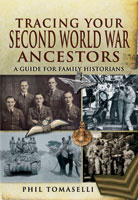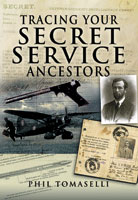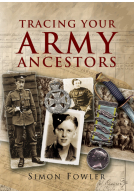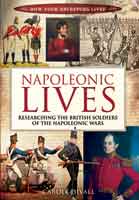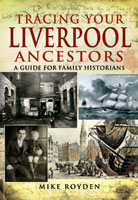Tracing Your Air Force Ancestors First Edition (Paperback)
Imprint: Pen & Sword Family History
Series: Tracing Your Ancestors
ISBN: 9781844155736
Published: 19th July 2007
Last Released: 21st September 2007
(click here for international delivery rates)
Need a currency converter? Check XE.com for live rates
| Other formats available | Price |
|---|---|
| Tracing Your Air Force Ancestors… ePub (8.4 MB) Add to Basket | £6.99 |
Whether you are interested in the career of an individual air-man or woman, researching medals awarded to a pilot or crew member or just want to know more about a particular squadron or operation, this book will point you in the right direction. Assuming that the reader has no prior knowledge of the air force, its history or organization, Phil Tomaselli explains which records survive, where they can be found and how they can help you in your research. He also recommends resources available online as well as books and memoirs. Each era in air force history is described, from the pioneering days of early aviation and the formation of the Royal Flying Corps in the First World War to the creation of the Royal Air Force, its operations during the Second World War and its postwar development. The author explains the evolving organization of the air force in each period. He also provides pointers and examples which should help researchers find the records of units and bases that individuals served in.
Author features as expert in Q&A article
WDYTYA? Magazine, November 2019
Author features as expert in Q&A article
WDYTYA? magazine October 2019
Author features as expert in Q&A
WDYTYA? Magazine, August 2019
Author features as expert in Q&A article
WDYTYA? Magazine, April 2019
Author features as expert in Q&A article
WDYTYA? February 2019
Author article 'Find Your First World War Army Ancestors Online' as featured by
WDYTYA? magazine, November 2018
This is another interesting title in the “Tracing Your xxx Ancestors” series. The Royal Air Force (RAF) is the youngest of the three branches of the Armed Forces and the author has written an outstanding text covering its evolution.
Military Archive Research.com
He begins with how the RAF started and enlightens the reader on some little known issues. The fathers of modern military flying were in actual fact the Royal Engineers (RE). The RE used balloons during the Victorian era and made expeditions to Bechuanaland (1884/5) and Egypt (1885). The book describes the records for this era.
Then the formation of the Royal Flying Corps (RFC) is noted. The RFC started with a naval and military wing. This affects any research into the subject and the distinction sets the background for subsequent chapters in the book. There are two very extensive chapters on the RFC and the Royal Naval Air Service (RNAS) during the First World War (WW1). The records for these two elements are noted in extensive detail. Issues such as service records, medical records, unit histories, balloon operations, combat reports and prisoners of war are considered in the chapter on the RFC. There are a number of pages devoted to the Battle of the Somme and examples of research into individual servicemen.
The chapter on the RNAS (in WW1) also has information on service record and ships’ logs. The latter are especially important when researching seaplanes and / or aircraft carriers. One particular point is that not all of the RNAS transferred to the RAF on its formation. According to the book about 2,000 RNAS personnel had their transfers annulled. This is not a well known fact and what is even less well known is that the RNAS operated Armoured Car Units! The book enlightens the reader on these unusual issues.
The author then considers the creation of the RAF and the Women’s Royal Air Force (WRAF). The RAF was created on the 1st April 1918 via the merger of the RFC and the RNAS. Similarly the WRAF was created by amalgamating the air units of the Women’s Royal Naval Air Service, the Women’s Auxiliary Army Corps, the Voluntary Aid Detachment and the Women’s Legion. The author points out that there are no surviving service records for WRAF officers but those for many of the WRAF other ranks have survived.
There is information on RAF operations shortly after WW1 in North Russia (1918-19), South Russia and Somaliland and Mesopotamia. Useful references are given for researching these operations. Then the text moves on to the RAF in the inter-war years. It describes the formation of the RAF Reserve, the standardisation of unit records via Operational Record Books (ORBs), the RAF List, operations such as Iraq (1920s) and units based in India.
Some very extensive and substantial chapters then follow on the main RAF commands. Details about Fighter Command (especially during the Battle of Britain), Bomber Command (e.g. the 1,000 bomber raid on Cologne 30/31 May 1942) and Coastal Command are given. Other records for WW2 are noted and the book gives particular reference to the RAF Confidential List which details the postings of officers. This list was published on a very controlled manner and is often overlooked by researchers. Various comments are made about researching units, prisoners of war, log books, RAF nurses, the Women’s Auxiliary Air Force, the RAF Regiment, the Fleet Air Arm, Army Pilots (air observation), the Glider Pilot Regiment and the Air Transport Auxiliary.
Chapter 8 considers the RAF after 1945 and the post-war records of the RAF are examined. It discusses how the 460 squadrons and one million personnel were demobilised at the end of World War 2. There are sections detailing post-war army aviation and Fleet Air Arm records, and issues relating to National Servicemen. Information concerning post-WW2 operations in Palestine, the Berlin Airlift, Korea, Malaya, Kenya and Suez are all given in detail.
The main text of the book then finishes with medals, casualties and court martial. The former is covered in detail whilst the latter two are given a less comprehensive treatment. There are 12 useful appendices and they cover the Order of Battle of the RAF and its predecessors, the ranking system and other useful sources.
This text is a commendable effort and extremely well written. Its structure is easy to follow whilst giving references which can be used. The topics covered include personnel issues and operations - the two main elements of researching the air based services. For Air Force historians or genealogists covering the Air Forces then this book is a “must have” for their reference library.
Highly Recommended!
Genealogists Magazine
About Phil Tomaselli
Phil Tomaselli has written extensively on military and family history and he has made a special study of the Western Front, in particular the decisive campaign of 1918. He has published many articles on aspects of army and air force history.








